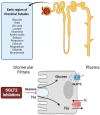Unlocking the Full Potential of SGLT2 Inhibitors: Expanding Applications beyond Glycemic Control
- PMID: 37047011
- PMCID: PMC10094124
- DOI: 10.3390/ijms24076039
Unlocking the Full Potential of SGLT2 Inhibitors: Expanding Applications beyond Glycemic Control
Abstract
The number of diabetic patients has risen dramatically in recent decades, owing mostly to the rising incidence of type 2 diabetes mellitus (T2DM). Several oral antidiabetic medications are used for the treatment of T2DM including, α-glucosidases inhibitors, biguanides, sulfonylureas, meglitinides, GLP-1 receptor agonists, PPAR-γ agonists, DDP4 inhibitors, and SGLT2 inhibitors. In this review we focus on the possible effects of SGLT2 inhibitors on different body systems. Beyond the diabetic state, SGLT2 inhibitors have revealed a demonstrable ability to ameliorate cardiac remodeling, enhance myocardial function, and lower heart failure mortality. Additionally, SGLT2 inhibitors can modify adipocytes and their production of cytokines, such as adipokines and adiponectin, which enhances insulin sensitivity and delays diabetes onset. On the other hand, SGLT2 inhibitors have been linked to decreased total hip bone mineral deposition and increased hip bone resorption in T2DM patients. More data are needed to evaluate the role of SGLT2 inhibitors on cancer. Finally, the effects of SGLT2 inhibitors on neuroprotection appear to be both direct and indirect, according to scientific investigations utilizing various experimental models. SGLT2 inhibitors improve vascular tone, elasticity, and contractility by reducing oxidative stress, inflammation, insulin signaling pathways, and endothelial cell proliferation. They also improve brain function, synaptic plasticity, acetylcholinesterase activity, and reduce amyloid plaque formation, as well as regulation of the mTOR pathway in the brain, which reduces brain damage and cognitive decline.
Keywords: SGLT2 inhibitors; bone minerals; cancer; cardiorenal effects; cardiovascular effects; cognitive effects; metabolism.
Conflict of interest statement
There is no conflict of interest.
Figures
Similar articles
-
Expanding access to newer medicines for people with type 2 diabetes in low-income and middle-income countries: a cost-effectiveness and price target analysis.Lancet Diabetes Endocrinol. 2021 Dec;9(12):825-836. doi: 10.1016/S2213-8587(21)00240-0. Epub 2021 Oct 14. Lancet Diabetes Endocrinol. 2021. PMID: 34656210
-
Renal and Cardiac Implications of Sodium Glucose Cotransporter 2 (SGLT2) Inhibitors: The State of the Science.Ann Pharmacother. 2018 Dec;52(12):1238-1249. doi: 10.1177/1060028018783661. Epub 2018 Jun 17. Ann Pharmacother. 2018. PMID: 29911393
-
How Do SGLT2 (Sodium-Glucose Cotransporter 2) Inhibitors and GLP-1 (Glucagon-Like Peptide-1) Receptor Agonists Reduce Cardiovascular Outcomes?: Completed and Ongoing Mechanistic Trials.Arterioscler Thromb Vasc Biol. 2020 Mar;40(3):506-522. doi: 10.1161/ATVBAHA.119.311904. Epub 2020 Jan 30. Arterioscler Thromb Vasc Biol. 2020. PMID: 31996025 Review.
-
The pharmacokinetics and pharmacodynamics of SGLT2 inhibitors for type 2 diabetes mellitus: the latest developments.Expert Opin Drug Metab Toxicol. 2018 Dec;14(12):1287-1302. doi: 10.1080/17425255.2018.1551877. Epub 2018 Nov 29. Expert Opin Drug Metab Toxicol. 2018. PMID: 30463454 Review.
-
Unveiling the mTOR pathway modulation by SGLT2 inhibitors: a novel approach to Alzheimer's disease in type 2 diabetes.Metab Brain Dis. 2025 Feb 26;40(3):132. doi: 10.1007/s11011-025-01555-4. Metab Brain Dis. 2025. PMID: 40009301 Review.
Cited by
-
A comprehensive meta-analysis on safety outcomes reveals the novel potentials of SGLT2is, especially preventing respiratory diseases.Front Endocrinol (Lausanne). 2024 Apr 29;15:1376446. doi: 10.3389/fendo.2024.1376446. eCollection 2024. Front Endocrinol (Lausanne). 2024. PMID: 38742192 Free PMC article. No abstract available.
-
The Influence of Performance Status, Inflammation, and Nutrition on the Impact of SGLT2 Inhibitors on Cancer Outcomes.Cancer Med. 2025 Mar;14(6):e70807. doi: 10.1002/cam4.70807. Cancer Med. 2025. PMID: 40116494 Free PMC article.
-
Genomic insights about the effect of sodium-glucose cotransporter 2 inhibitors: a systematic review.Front Genet. 2025 May 30;16:1571032. doi: 10.3389/fgene.2025.1571032. eCollection 2025. Front Genet. 2025. PMID: 40520225 Free PMC article.
-
Management and Diagnosis of Empagliflozin-Induced Burning Mouth Syndrome: A Case Report.Cureus. 2024 Oct 2;16(10):e70701. doi: 10.7759/cureus.70701. eCollection 2024 Oct. Cureus. 2024. PMID: 39493170 Free PMC article.
-
Incidence and predictors of chronic kidney disease among patients with diabetes treated at governmental hospitals of Harari Region, eastern Ethiopia, 2022.Front Public Health. 2024 Jan 5;11:1290554. doi: 10.3389/fpubh.2023.1290554. eCollection 2023. Front Public Health. 2024. PMID: 38249421 Free PMC article.
References
-
- Eyre H., Kahn R., Robertson R.M., ACS/ADA/AHA Collaborative Writing Committee. ACS/ADA/AHA Collaborative Writing Committee Members. Clark N.G., Doyle C., Hong Y., Gansler T., Glynn T. Preventing cancer, cardiovascular disease, and diabetes: A common agenda for the American Cancer Society, the American Diabetes Association, and the American Heart Association. Circulation. 2004;109:3244–3255. doi: 10.1161/01.CIR.0000133321.00456.00. - DOI - PubMed
-
- Campbell-Tofte J.I., Mølgaard P., Winther K. Harnessing the potential clinical use of medicinal plants as anti-diabetic agents. Bot. Targets Ther. 2012;2:7–19. doi: 10.2147/BTAT.S17302. - DOI
Publication types
MeSH terms
Substances
LinkOut - more resources
Full Text Sources
Medical
Miscellaneous






